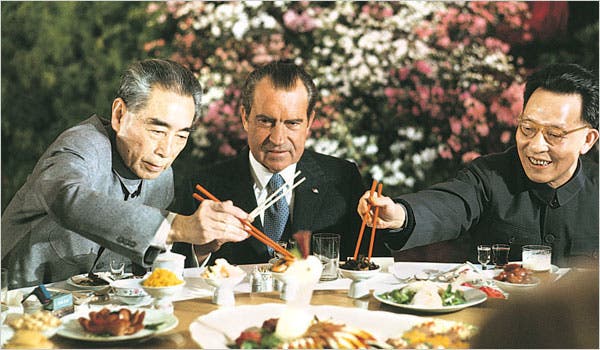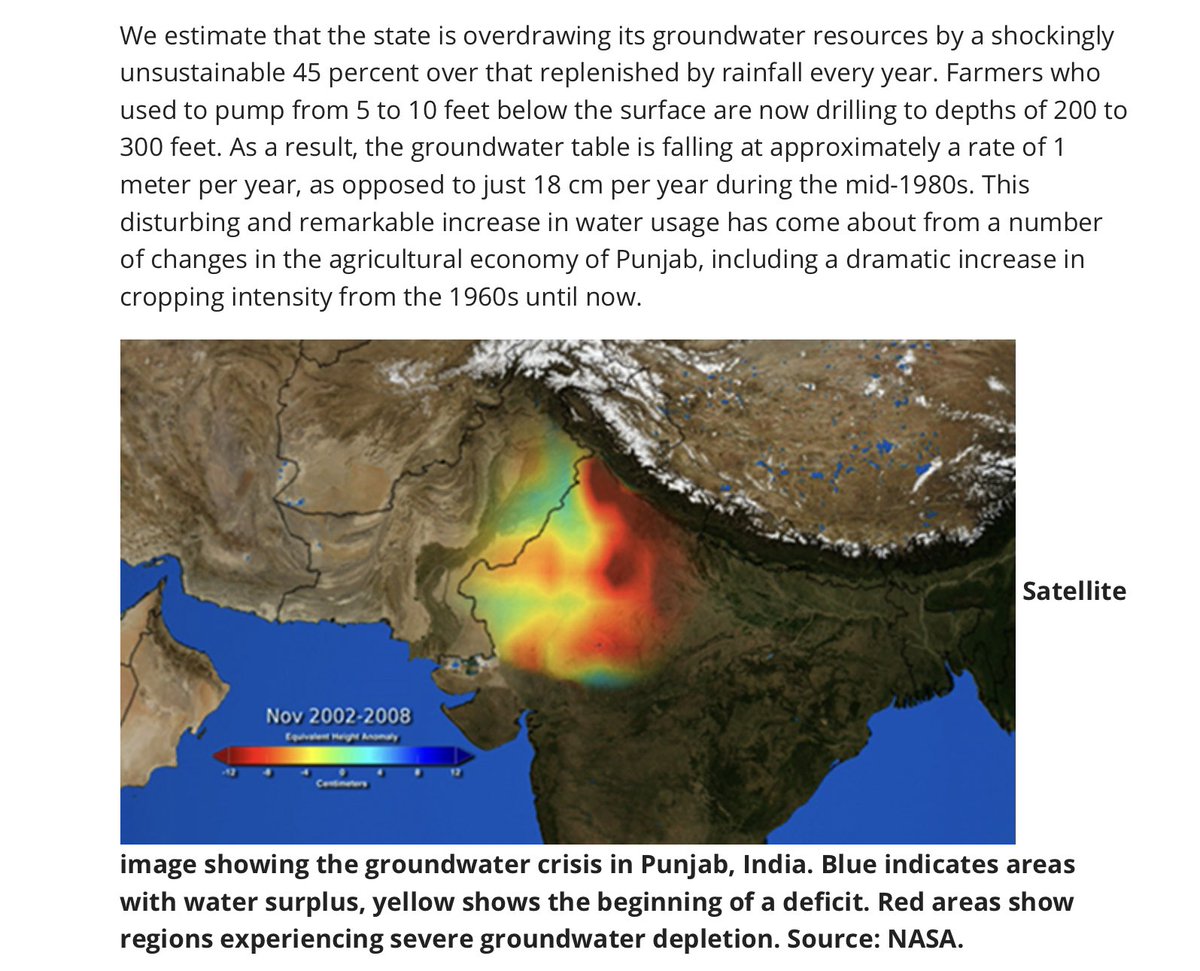
Some notes on America's affair with the Fed & with China.
A brief history of America, the Federal Reserve, & China's economic relationship. 🇺🇸🇨🇳🪙
A brief history of America, the Federal Reserve, & China's economic relationship. 🇺🇸🇨🇳🪙
Let's start with the CCP taking power in China. After a century of humiliation & the subsequent strife/civil war. Mao Zedong's CCP took power in China in 1949. An economic & demographic catastrophe followed as the Great Leap Forward fell & Cultural Revolution ruined China. 

The US, on the other hand, was riding the waves of victory post-WW2 and preparing its booming economy & military for the next conflict on the horizon - communism. America would soon become an empire as it fanned across the world to contain this Red Enemy.
The USSR was obviously enemy #1 as it had succeeded in revolutionizing itself into a formidable superpower. China was floundering and flailing with Mao's policies. It wasn't seen as much of a threat at the moment.
While the US tiraded against these hyper centrally planned states, it too took advantage of centralized state capacity. Besides the obvious New Deal that recently occurred, we also had the birth and empowerment of the Federal Reserve in 1913. A money printer was invented.
Below you'll see an amazing visual by @VisualCap that shows some of the consequences of US monetary policy, primarily shaped by the Fed - particularly with regards to the purchasing power of the US Dollar $
Source & Details: visualcapitalist.com/purchasing-pow…
Source & Details: visualcapitalist.com/purchasing-pow…

Post-WW2, American interventionism was in vogue. The government had to spend big to enact its adventures and the Fed had to keep the printer on to fund it all. You would think there would be crippling inflation (bouts did happen) but American trade policy helped stymie it.
The US would put special focus on Japanese trade as they procured supplies during the Korean War. Japan industrialized & reformed rapidly, essentially becoming the US's "China" before China itself. Cheap goods and exports from Japan streamed into America. A taste of the future.
And the Fed kept printing...
In 1971, President Nixon and co believed that the US didn't have enough gold reserves to cover the US Dollars in circulation. He would then unpeg the $ from gold and establish it as a free-floating fiat currency.
In 1971, President Nixon and co believed that the US didn't have enough gold reserves to cover the US Dollars in circulation. He would then unpeg the $ from gold and establish it as a free-floating fiat currency.
Another bang would occur in the 1970s as incensed Arab states held their oil at ransom after war with Israel. Inflation shot up & the black blood that drove the US economy would dry up. Nixon would respond by hashing out an agreement with OPEC; the petrodollar was born.
Essentially, oil could only be traded in US Dollar. Oil became pegged to the USD in a way and the world could only acquire the most precious resource on the planet if they had US Dollars.
I write about the prelude and the fallout of this exchange here:
theemissary.co/a-tale-of-oil-…
I write about the prelude and the fallout of this exchange here:
theemissary.co/a-tale-of-oil-…
Concurrently to all this, Nixon (at this point, we can say Nixon was an EXTREMELY consequential President) opened relations with China and a meaningful magnitude of trade slowly accumulated.
China would soon become America's factory. But we have to wait a bit for that...
China would soon become America's factory. But we have to wait a bit for that...

Regardless of the previous 2 reforms that some would thing would curb inflation, it exploded. Peaking near 15% in 1980. Interest rates followed the spike and business slowed down with unemployment 7.8% in 1980.
Stagflation had come.

Stagflation had come.


Paul Volcker would take over the Fed in 1979 just prior to the 1980 inflation top. He would bravely introduce policies to ⬇️the Fed's reserve growth & ⬆️ interest rates; policies that would deliver a bitter pill of 10.8% unemployment in 1982, but eventually curb inflation.
Volcker's heroics would give way to the Fed soon reverting to its expansionary mood. But this time, it wouldn't result like past inflation. America's account with China was growing and cheap goods imported from China would give breathing room to the Fed's monetary adventures.
While inflation didn't occur on Main Street, it would arise at Wall Street. Assets such as equities and real estate would be where the Fed's money printing manifested. Innovations in technology further pushed corporate profits forward & deflated costs across many industries.
"Easy money and an excessive credit expansion leads to over-investments." Eventually reality caught up in the late 1980s and the bubble burst. Over-investment and a phobia of saving also lead to debt that hemorrhaged with the bust. 

Right on cue, interest rates would be slashed in the late 80s and the trend would continue as it had done prior. Artificially low rates would eventually push real estate prices higher as well. 



While the US danced with the Fed, China had begun to reform and liberate its economy. Rapid industrialization occurred to meet American demand for cheap manufactured goods. Cut and dry communism was replaced with state command capitalism. An economic miracle would occur. 

American manufacturing began to rapidly hollow out. It became dependent on Chinese manufacturing while China gained valuable knowledge from American sources, component needs, and technology as it was integral in supplying crucial parts for the Tech boom.
A realization of future reckoning dawned on the Chinese and some Americans. Other Americans, many of whom held the reins of elite and institutional power, foolishly believed that China would follow economic reforms with political reforms into a Liberal Democracy...
China would keep its export prices low by devaluing its currency. China would start accumulating the US $/Treasury debt of the US in this vein. Chinese exporters get paid in $, while the Chinese central bank buys these $ & gives importers freshly printed Yuan creating $ scarcity. 

Essentially, China was upholding the USD as reserve currency of the world. Some say there is a clandestine strategy where China is accumulating secret gold reserves for when they ween off the USD. Possible but also possibly farfetched.
bullionstar.com/gold-universit…
bullionstar.com/gold-universit…
With the twin drops of 2008 and 2020 in the US economy, the US embarked on radical Quantitative Easing introducing huge amounts of currency into the markets. Yet Chinese (and world) demand for USD still remained strong as knock on effects echoed. 

Now we enter uncharted territory, as the US & China increasingly are becoming antagonistic and the Chinese slowly decrease the percentage of US Dollars in their foreign reserves.
The Fed, as done prior, just keeps printing.
blogs.imf.org/2021/05/05/us-…
The Fed, as done prior, just keeps printing.
blogs.imf.org/2021/05/05/us-…
• • •
Missing some Tweet in this thread? You can try to
force a refresh








